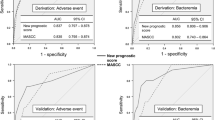Abstract:
Objective
The objective of this study was to prospectively validate the Multinational Association of Supportive Care of Cancer (MASCC) risk-index score in an attempt to accurately predict on presentation with febrile neutropenia those cancer patients who are at low- or high-risk for development of serious medical complications during the episode.
Patients and methods
Patients who presented with febrile neutropenia during November 2000 and July 2002 were prospectively enrolled in the protocol. All patients were hospitalized until recovery or outcome of the event and were treated with broad-spectrum, empiric, intravenous antibiotic therapy. The MASCC risk-index score (based on seven independent factors present at onset of febrile neutropenia) was calculated in 64 patients with 80 febrile neutropenic episodes. Patients with a score of ≥21 were regarded as low risk; patients with a score of <21 were regarded as high risk.
Results
Of the 80 febrile neutropenic episodes, 58 were classified as low-risk and 22 as high-risk patients. Fifty-seven (98.3%) of the 58 low-risk patients recovered without complications, and three (13.6%) of the 22 high-risk patients did not develop medical complications. One low-risk patient developed a fungal infection but recovered completely in comparison to 11 high-risk patients (50%) who developed serious medical complications (p<0.001). None of the low-risk patients died. However, eight (36.4%) of the 22 high-risk patients died during the febrile neutropenic episode (p<0.001), six as a consequence of sepsis and two due to rapidly uncontrolled cancer.
Conclusion
We correctly predicted 98.3% of low-risk patients and 86.3% of high-risk patients. This study had a positive predictive value of 98.3% and a negative predictive value of 86.4% with both a sensitivity and specificity of 95%. The MASCC risk-index score correctly identifies low- and high-risk patients at presentation with febrile neutropenia.
Similar content being viewed by others
References
Bodey GP, Buckley M, Sathe YS, Freireich EJ (1966) Quantitative relationships between circulating leukocytes and infection in patients with acute leukemia. Ann Intern Med 64:328–340
Feld R (2000) Multinational cooperation in trials and guidelines dealing with febrile neutropenia. Int J Antimicrob Agents 16:185–187
Hughes WT, Amstrong D, Body GP, Brown AE, Edwards JE, Feld R, Pizzo P, Rolston KVI, Shenep JL, Young LS (1997) Guidelines from the infectious diseases society of America. 1997 guidelines for the use of antimicrobial agents in neutropenic patients with unexplained fever. Clin Infect Dis 25:551–573
Klastersky J, Paesmans M, Ruberstein EB, Boyer M, Elting L, Feld R, Gallagher J, Herrstedt J, Rapoport B, Rolston K, Talcott JA for the Study Section on Infections of Multinational Association for Supportive Care in Cancer (2000) The Multinational Association for Supportive Care in Cancer Risk Index: A Multinational scoring system for identifying low-risk febrile neutropenic cancer patients. J Clin Oncol 18:3038–3051
Paesmans M, Rapoport B, Maertens J, Slabber C, Ferrant A, Wingard J, Aoun M, Dubreucq L, Plehiers B, Klastersky J (2003) Multicentric prospective validation of the MASCC risk-index score for identification of febrile neutropenic cancer patients at low-risk for serious medical complications. Proc Amer Soc Clin Oncol (2235)
Pizzo PA, Amstrong D, Bodey GP, de Pauw B, Feld R, Glauser MP, Gaya H, Karp J, Klastersky J, Todeschini G, Verhoef J, Wade J, Young LS, Remington J, the Immunocompromised Host Society (1990) The design, analysis and reporting of clinical trials on the empirical antibiotic management of the neutropenia patient. J Infect Dis 161:397–401
Schimpff SC (1986) Empiric antibiotic therapy for granulocytopenic cancer patients. Am J Med 80:13–20
Talcott JA, Finberg R, Mayer RJ, Goldman L (1988) The medical course of cancer patients with fever and neutropenia. Clinical identification of a low-risk subgroup at presentation. Arch Intern Med 148:1561–2568
Talcott JA, Siegel RD, Finberg R, Goldman L (1992) Risk assessment in cancer patients with fever and neutropenia: a prospective, two-center validation of a prediction rule. J Clin Oncol 10:316–322
Talcott JA, Whalen A, Clark J, Rieker PP, Finberg R (1994) Home antibiotic therapy for low-risk patients with fever and neutropenia: a pilot study of 30 patients base on a validated prediction rule. J Clin Oncol 12:107–114
Author information
Authors and Affiliations
Corresponding author
Rights and permissions
About this article
Cite this article
Uys, A., Rapoport, B.L. & Anderson, R. Febrile neutropenia: a prospective study to validate the Multinational Association of Supportive Care of Cancer (MASCC) risk-index score. Support Care Cancer 12, 555–560 (2004). https://doi.org/10.1007/s00520-004-0614-5
Received:
Accepted:
Published:
Issue Date:
DOI: https://doi.org/10.1007/s00520-004-0614-5



